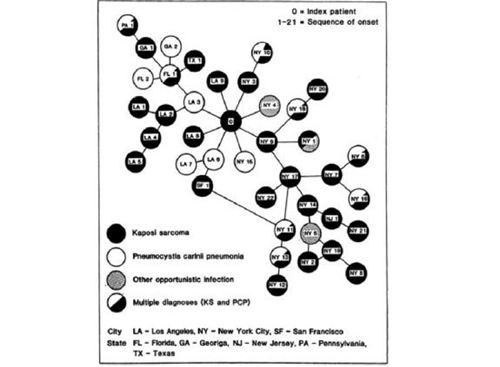Clearest-ever study of HIV’s North American origins exonerates Canada’s ‘patient zero’
Flight attendant Gaetan Dugas had long been vilified for spreading AIDS in the 1970s, but new genetic research shows the virus was circulating for years before he was infected.
 Gaetan Dugas, an Air Canada flight attendant, was vilified as "Patient Zero" of the early U.S. AIDS epidemic. New research shows other patients had the virus earlier. Dugas died of AIDS on March 30, 1984.
Gaetan Dugas, an Air Canada flight attendant, was vilified as "Patient Zero" of the early U.S. AIDS epidemic. New research shows other patients had the virus earlier. Dugas died of AIDS on March 30, 1984.
(Anonymous / ASSOCIATED PRESS) By Jennifer Yang Global health reporter
Wed., Oct. 26, 2016
In 1981, the New York Times published one of the first articles describing a mysterious new disease. “Doctors investigating the outbreak believe that many cases have gone undetected,” the story read. By the following year, health officials had given the disease a name: AIDS.
Thirty-five years later, the full extent of the HIV virus's early spread remains unknown. But in a new study published Wednesday, researchers used an innovative new technique to decode the oldest HIV genomes found outside of Africa, allowing them to write a crucial chapter in the pandemic's early history — when and where HIV emerged in the United States.
According to the study, published in Nature, the HIV virus had already spread from the Caribbean to New York City by around 1970 — a full decade before doctors first noticed the signs of AIDS. From there, the pandemic strain spread to California and beyond.
The paper also provides clear scientific evidence that Gaetan Dugas — the French-Canadian flight attendant vilified as North America's “patient zero” — was “simply one of thousands infected before HIV/AIDS was recognized,” co-author Richard McKay said Tuesday.
For veterans of the field, this new study offers a new gene sequencing technique that can be used to study not just HIV but everything from Zika to cancer.
And as the paper demonstrates, the ability to peer into DNA is powerful — capable of illuminating dark chapters in history, tracing a pandemic's evolution, and telling human stories that cross space and time.
“I think this paper will be kind of a landmark in understanding HIV's history,” said John Coffin, a professor of molecular biology at Tufts University who helped name the Human Immunodeficiency Virus in 1986. He was not involved with the study.
“The power of these kinds of analyses is just astonishing. Back in the 80s, I would have considered this (type of research) to be pure science fiction.”
The study is also, in itself, the latest chapter in another story: The scientific search for the origin of HIV/AIDS.
The study's first author, Canadian scientist Michael Worobey with the University of Arizona, has been tracking the virus since the late 90s. In January 2000, he and the evolutionary biologist William Hamilton travelled to the Democratic Republic of Congo, where they collected fecal and urine samples from chimpanzees to search for the virus that spawned the HIV pandemic.
Eight years later, Worobey published a paper analyzing a biopsy specimen, which was fortuitously found in a pantry at the back of a university laboratory in Kinshasa. A genetic analysis showed that HIV was already present in the DRC by 1960 — and may have jumped into humans as early as 1908.
Another paper published by Worobey in 2007 also found that HIV likely spread from Africa to Haiti in or around 1966. In the Caribbean, it then circulated for years before a “single migration of the virus out of Haiti in or around 1969.”
Worobey's latest paper picks up the story from there.
Scientists had never uncovered any North American HIV genomes from earlier than 1980 but Worobey managed to track down old blood samples from 1978 and 1979. They were collected from gay men in New York City and San Francisco as part of a Hepatitis B study, and preliminary tests showed that some samples had signs of HIV infection.
Unfortunately, the samples were degraded and Worobey had to spend several years developing the “jackhammering” technique that ultimately allowed him to retrieve the full genomes. He wound up reconstructing HIV genomes from eight patients — the oldest ever sequenced from North America.
By comparing the genomes — both with each other and with more recent HIV sequences — researchers could build an evolutionary tree, showing where each genome was located in HIV's viral lineage.
“When you step back in time, you see a very interesting pattern,” Worobey told reporters in news conference Tuesday.
“It's sort of direct evidence of many years of circulation of this virus in the United States before HIV and AIDS were finally recognized … we can date the jump into the United States at about 1970 or ‘71.”
A key hub for the outbreak was New York City, where “the virus encountered a population that was like dry tinder, causing the epidemic to burn hotter and faster and infecting enough people that it grabs the world's attention for the first time,” Worobey explained in a press release.
And while AIDS was first reported by a doctor in California, the study found that “the bulk” of San Francisco's HIV infections in 1978 “traced back to a single introduction from NYC in 1976.”
The study also corrects another story from HIV's early history: That of Gaetan Dugas, the gay French-Canadian flight attendant who died from AIDS in 1984.
Dugas, who was hired by Air Canada in 1974, was one of 40 men in a sexual network identified by researchers with the U.S. Centers for Disease Control and Prevention, who initially described him as Patient O, for “outside-of-California” — a label that was ultimately misinterpreted as “Patient 0.” The Canadian's “patient zero” status was further cemented by the bestselling book “And the Band Played On”.

A graphic from a 1984 study of early AIDS patients shows a cluster of sexual relationships surrounding a "Patient 0," later identified as Canadian Gaetan Dugas. Although labelled the "index patient," Dugas was not the primary source of HIV in this cluster and new research shows the virus had been circulating in North America for years before Dugas was likely infected. (Nature)
The patient zero myth has been widely debunked, but it has managed to persist over the years. So in their study, Worobey manages to finally sequence an HIV genome from Dugas — and “found no evidence that Patient 0 was the first person infected by this lineage,” according to the paper.
“One of the dangers of focusing on a single patient zero when discussing the early phases of an epidemic is that we risk obscuring important structural factors that might contribute to its development: poverty, legal and cultural inequalities, barriers to health care and education,” said co-author McKay, a historian with the University of Cambridge who is now writing a book about Dugas and the early days of AIDS.
For Coffin, research that illuminates the early history of the HIV pandemic is more relevant than ever. New viruses are emerging all the time and understanding the past will prepare us for future pandemics, he said.
For Dan Allman , acting director of the HIV Studies Unit at U of T's Dalla Lana School of Public Health, the story of Dugas also serves as a cautionary tale. Narratives can be a powerful tool for understanding a terrifying new disease; they can also be misleading and destructive.
“It's one thing for an epidemiologist to look for an index case; it's another thing for society to look for a patient zero because that patient can become the scapegoat for a whole array of social ills,” he said. “One does have to wonder what the impact was — not only on Gaetan, but also on his family and his friends.” ###
Source: Toronto Star
"Reproduced with permission - Torstar Syndication Services"
Toronto Star
For more HIV and AIDS News visit...
Positively Positive - Living with HIV/AIDS:
HIV/AIDS News |